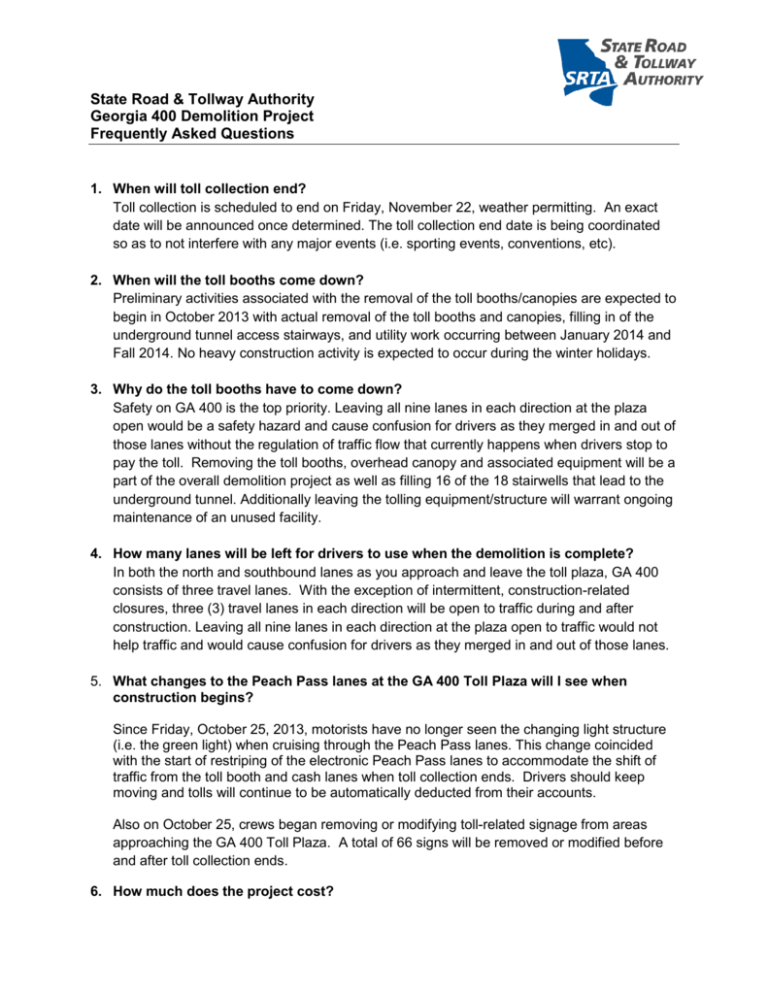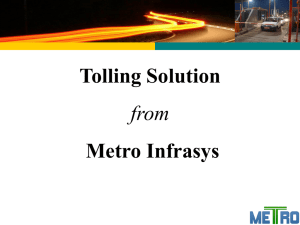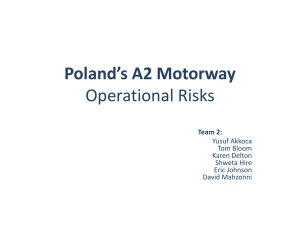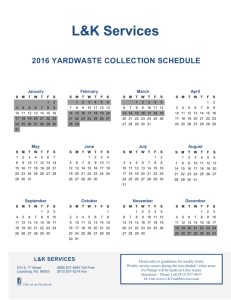State Road & Tollway Authority Georgia 400
advertisement

State Road & Tollway Authority Georgia 400 Demolition Project Frequently Asked Questions 1. When will toll collection end? Toll collection is scheduled to end on Friday, November 22, weather permitting. An exact date will be announced once determined. The toll collection end date is being coordinated so as to not interfere with any major events (i.e. sporting events, conventions, etc). 2. When will the toll booths come down? Preliminary activities associated with the removal of the toll booths/canopies are expected to begin in October 2013 with actual removal of the toll booths and canopies, filling in of the underground tunnel access stairways, and utility work occurring between January 2014 and Fall 2014. No heavy construction activity is expected to occur during the winter holidays. 3. Why do the toll booths have to come down? Safety on GA 400 is the top priority. Leaving all nine lanes in each direction at the plaza open would be a safety hazard and cause confusion for drivers as they merged in and out of those lanes without the regulation of traffic flow that currently happens when drivers stop to pay the toll. Removing the toll booths, overhead canopy and associated equipment will be a part of the overall demolition project as well as filling 16 of the 18 stairwells that lead to the underground tunnel. Additionally leaving the tolling equipment/structure will warrant ongoing maintenance of an unused facility. 4. How many lanes will be left for drivers to use when the demolition is complete? In both the north and southbound lanes as you approach and leave the toll plaza, GA 400 consists of three travel lanes. With the exception of intermittent, construction-related closures, three (3) travel lanes in each direction will be open to traffic during and after construction. Leaving all nine lanes in each direction at the plaza open to traffic would not help traffic and would cause confusion for drivers as they merged in and out of those lanes. 5. What changes to the Peach Pass lanes at the GA 400 Toll Plaza will I see when construction begins? Since Friday, October 25, 2013, motorists have no longer seen the changing light structure (i.e. the green light) when cruising through the Peach Pass lanes. This change coincided with the start of restriping of the electronic Peach Pass lanes to accommodate the shift of traffic from the toll booth and cash lanes when toll collection ends. Drivers should keep moving and tolls will continue to be automatically deducted from their accounts. Also on October 25, crews began removing or modifying toll-related signage from areas approaching the GA 400 Toll Plaza. A total of 66 signs will be removed or modified before and after toll collection ends. 6. How much does the project cost? Total project cost is approximately $4.5 million with $3.5 million in construction cost. 7. Who is paying for the project? The State Road and Tollway Authority (SRTA) is funding the project cost, while the Georgia Department of Transportation (GDOT) will oversee construction and traffic management. 8. What delays can be expected during construction? Traffic flow will continue to utilize three general purpose travel lanes throughout the length of the project. However, as with any transportation related construction, traffic patterns may change. So, during the project, motorists should allow a little extra time and/or consider other transportation options, such as transit, in the GA 400 corridor. 9. Will the existing toll plaza building also be demolished? No. The cash lane toll booths and overhead canopy will be demolished and removed; however, the toll plaza building located just off the shoulder in the northbound direction will remain. The ownership of the building, which is currently leased by SRTA for operations of GA 400, will be returned to GDOT. 10. What is happening to the GA 400 toll equipment? Equipment that can be re-used in existing toll facilities on I-85 and future tolling projects will be saved. 11. The tolls were extended in 2010 and now they are ending. Why? The tolls were extended in order to fully complete the project as originally designed and fund additional needed projects along the GA 400 extension. Prior to the original construction of the 6.2 mile extension, traffic projections did not show enough demand to justify the cost of ramps from I-85 south to GA 400 north and from GA 400 south to I-85 north. Traffic has exceeded all projections and those connector ramps are needed to relieve congestion around Sidney Marcus Boulevard, Buford Highway Connector, Lenox Road and Piedmont Road. Governor Nathan Deal committed to finding a way to fulfill the original promise to end tolling as soon as outstanding debt could be paid off without cancelling project commitments designed to benefit the entire GA 400 corridor. Commuters are getting the benefit of the 14 projects funded by toll reserves and the connector ramps funded by the toll extension and will now have a toll-free facility to use. 12. How many drivers will be affected by the project? Approximately 119,000 people use the 6.2-mile system every weekday. Approximately 45 percent of all vehicles travelling GA 400 use the Peach Pass for cashless payment of tolls. 13. What is the toll money used for? The average weekday revenue collected at the toll plaza on GA 400 is approximately $59,000 per day. All tolls collected are used to pay down bond debt, operate and maintain the road and assist in financing SRTA’s overall operations. SRTA has committed more than $60 million in funding representing 14 transportation projects along the GA 400 corridor. 14. How will future projects be funded? The extension of the tolls completed many of the long needed projects throughout the GA 400 corridor. Future projects, such as improvements to the I-285 at GA 400 interchange, are being looked at closely and will be funded through current resources such as state and federal gas taxes. Priced managed lanes built on newly constructed lanes north of I-285 are also being studied and could potentially be funded through innovative financing models such as a public-private partnership. How will SRTA fund operations without the toll? Once the tolls end, SRTA will use a combination of revenues from the I-85 Express Lanes, state transportation funds and toll reserves to fund operations. 15. Will SRTA have to eliminate jobs? Yes, approximately 50 positions (approximately 1/3 of the personnel that work at SRTA) will be eliminated with the end of tolls on GA 400. Most of these positions are toll plaza cashiers. The cashiers at the GA 400 toll booths and their immediate supervisors work for SRTA through a contract with a private company. SRTA’s contract with that company will end after the tolls end. 16. How does a road become a toll road in Georgia? What is the process? The State Transportation Board has the sole authority to designate a road as a toll road in Georgia. Studies are frequently completed looking at the feasibility to build entirely new toll roads or new optional toll lanes on existing roads. Once the Transportation Board designates a road as a toll road, GDOT constructs the road and SRTA installs the tolling equipment. The SRTA Board establishes the toll rates and operates the toll system for as long as the roadway remains designated as a toll road by the State Transportation Board. This separation of responsibilities, by design, is a check and balance that keeps any one state entity from unilaterally establishing a toll road. 17. Where can I find additional information? For more detail on the project, go to the GA Tollway Demolition Project page on the SRTA website (www.peachpass.com). 18. What is the State doing to make my commute better on the GA 400 corridor? Governor Deal has stated that improvements to the GA 400/Interstate 285 interchange are a key Metro area transportation priority of his administration. Georgia DOT is working to develop a practical, affordable plan to make those improvements as soon as it is feasible and in such a manner as to accommodate other future improvements to both the 400 and I-285 corridors. In that regard, there is an ongoing study of the feasibility of managed lanes on the Ga 400 corridor from I-285 to SR 20. This study includes an analysis of possible alternatives and how they could best be implemented. We continue to work on environmental clearance for the revive 285 project (I-85 to I-75 on the top end) that will clear a footprint for long term improvements to the I-285/GA 400 interchange along with managed lanes and other operational improvements. 19. How will these improvements be funded? We are committed to an aggressive effort to improve mobility on both I-285 and GA 400 and in an financially responsible manner. Studies are currently underway to explore various funding options. 20. What additional commute options are available in the GA 400 corridor? The Georgia Commute Options program is a “one-stop” shop for commuters looking for other transportation options such as carpooling, vanpooling, transit, teleworking, etc. The program offers incentives for motorists who choose to use some of the various commute options. Programs like the GA Commute Options are part of a regional strategy to reduce traffic and improve air quality. Georgia Commute Options consultants also work with employers at no cost to create programs that help employees find the commute options that work best for them. Many workplaces in the GA 400 corridor are participating in the program. To learn more about Georgia Commute Options, visit GACommuteOptions.com or call 1-877-9-GAOPTIONS. 21. What specific transit/bus/rail service is in the GA 400 Corridor? Yes. Both MARTA and GRTA Xpress service are available in the GA 400 Corridor. MARTA (rail and bus) MARTA's Red Line rail stations include Buckhead, Medical Center, Dunwoody, Sandy Springs ending at North Springs. A train arrives every 15 minutes in the peak periods and every 20 minutes in the off peak. Patrons can take the ramp from GA 400 directly to the North Springs Station. The Red Line rail service ends at the Atlanta Airport. MARTA also operates bus service that feeds into the MARTA rail stations. MARTA has 10 bus routes and 2 Park and Ride facilities at Mansell Road and Windward Parkway in the North Fulton area. MARTA is conducting a study in the GA 400 corridor for future service development. MARTA's Connect 400 project is an Alternatives Analysis (AA) study that considers potential alignments and transit technologies while working with area stakeholders. Additional information on Connect 400 is available on the MARTA website at http://www.itsmarta.com/north-line-400-corr.asps. The MARTA fare is $2.50 one-way plus $1.00 for the Breeze fare card. A round trip is $5 plus the cost of the card. For more information go to the MARTA website at: http://www.itsmarta.com or call Customer Information at 404 848-5000. GRTA Xpress Coach Service Monday through Friday, Xpress service begins in Cumming and travels south on GA 400 – making stops at North Springs MARTA station or continue to Downtown Atlanta. There are eight inbound and eight outbound trips per week day which in 2012 hosted over 65,000 boardings. o Downtown service provides convenient access to major employers such as Georgia-Pacific, SunTrust, Coca-Cola Enterprises and Capital Hill, as well as, Five Points, Peachtree Center and North Avenue MARTA Stations One-way fares begin at $4 with roundtrip and multi-trip discounts available





